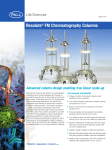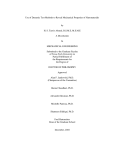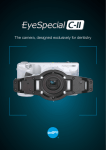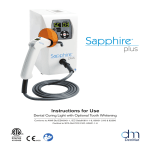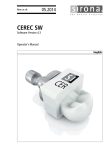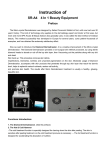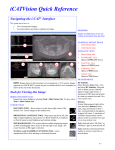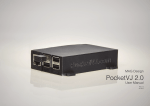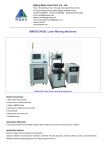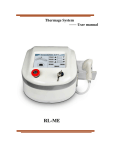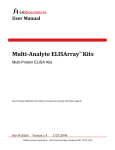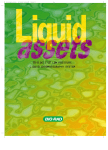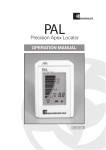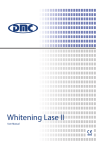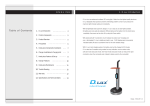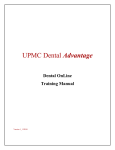Download HOW DO PIONEER DIODE LASERS WORK? Soft
Transcript
HOW DO PIONEER DIODE LASERS WORK? The Science Behind Pioneer Diode Lasers. Soft-Tissue Surgery Pioneer diode lasers are dentistry’s most user-friendly diode lasers to date. With a simplified control panel, the Pioneer diode lasers feature the latest and finest solid-state diode laser technology, accurate power output and a consistent wavelength for smooth, precise, and clean, tissue modification, and therapeutic procedures. The term “laser” stands for "Light Amplification by Stimulated Emission of Radiation", which means a device that produces and amplifies light. The wavelength of the light produced will determine what types of tissues can be modified by the light’s energy. Light waves that emanate from within the visible and near-infrared portions of the electromagnetic spectrum will be readily absorbed into body pigments like melanin in the skin, and heme found within hemoglobin in blood. They will have virtually no affinity for water and, thus, it won’t be absorbed at the surface as it enters soft tissues. Wavelengths located within the mid to far infrared range are attracted to water and the Hydroxyapatite crystals that are found within bone and teeth. Thus, these wavelengths are primarily used in hard-tissue lasers. With a frequency of 810+/-20 nanometers, the Pioneer diode laser’s wavelength falls into the lower end of the near-infrared spectrum, making it suitable for soft-tissue applications. Laser light can be emitted in either a continuous or pulsed temporal mode. The Pioneer diode lasers are designed to deliver both. Lasers require a power supply and an active medium in order to produce light. Dental lasers employ different active mediums such as the man-made rods found in the YAG lasers, liquids, gases or solid state semiconductor crystals like those found in diodes. The Pioneer diode lasers feature an aluminum, gallium and arsenide semiconductor crystal that is activated or “pumped” when an electrical current is passed through it, and it then produces an elliptical shaped display of monochromatic light. This light is then focused into a very small thread of light and directed into an optical fiber, which carries it to the target tissue. The resultant photothermal reaction results in vaporization at the cellular level. The laser creates an intense beam of light energy that moves through a fiber-optic cord. When it enters the targeted tissue, the energy is converted into heat as a result of the www.pioneerlasers.com tissue’s pigmentation. A photothermal reaction occurs that results in a much localized thermal effect causing vaporization (or ablation) of this targeted tissue, with “very little collateral tissue damage.” When using Pioneer diode lasers, dentists or hygienists (in states where the Dental Practice Act does not prohibit hygienists from using a laser) can change the mode of the laser (either pulsed or continuous wave), the power in Watts, and the current status — such as ready or stand-by. In the continuous mode, the laser energy is on continuously while the laser is activated. In this mode, the laser is faster and more efficient when used by experienced laser dentists. In the pulsed mode, the energy flow is interrupted by an electrical or mechanical shutter system. The pulsed mode is less aggressive and allows some tissue cooling between pulses. Selection of the mode used is up to the discretion of the operator, but care must be taken when moving from the pulsed mode with higher set powers to a continuous mode. Operators must adjust the power downward when switching to the continuous mode. The power of lasers is described in Watts, which is the rate of doing work. One Watt is equal to 1 Joule per second, and higher powers work faster. When Pioneer diode lasers are used in the continuous mode, the average power will be what the operator selects on the control panel. When used in pulsed mode, the pulse duration and number of pulses per second have been fixed at the factory, so neither can be adjusted by the operator. The average power will be half of the set power since the laser is only emitting energy half the time when in the pulsed mode. The primary use of a soft-tissue laser is the modification or removal of intra-oral soft tissue. The photothermal effects of the laser’s energy allow the operator to modify tissues and control hemostasis at the same time by coagulation. The post-operative response of the laser care will usually produce a cleaner and healthier surgical site with less discomfort when compared to alternative methods of surgery. Soft-tissue lasers enable minor surgical procedures and decontaminate the area at the same time. There is less chance of infection, and some soft-tissue procedures around the gingiva can be completed without anesthesia. The laser also promotes healing for infected and irritated tissues. Since there is a favorable response to laser treatment, the resultant healing is less complicated and often shorter when compared to traditional techniques. In many cases, the laser can also be used to treat deep gingival pockets that harbor bacteria and cause gum disease. An additional benefit of dental diode laser technology is its ability to reduce the pain and longevity of cold sores and fever blisters. www.pioneerlasers.com Therapeutics (Pain Therapy) Diode lasers can be used with a special handpiece to administer pain therapy through biostimulation and increased blood flow to patients suffering joint pain such as TMJ. The biostimulating effects of laser therapy also reduce inflammation and infection. When using the Pioneer Elite diode laser for therapeutic procedures, make sure the handpiece is assembled according to Section 6.6 of the User Manual and the appropriate laser settings are established as indicated in the Procedures table in Section 3.2.14. Position the handpiece over the target area and lightly contact the end of the handpiece onto the tissue. Press and hold the foot pedal down. Use consistent, circular motions to move the handpiece over the target area. Avoid holding the handpiece over the same area for more than a few seconds. Small treatment areas may not require the full 300 seconds of exposure time. Teeth Whitening For in-office teeth whitening procedures, diode lasers activate the whitening gel accelerating the whitening process for the most dramatic, fast in-office whitening available today. When using the Pioneer Elite for the Teeth Whitening procedure, make sure the handpiece is assembled according to Section 6.7 of the User Manual and the appropriate laser settings are established as indicated in the Procedures table in Section 3.2.14. Apply the whitening gel as indicated in the instructions for the whitening gel that you are using. Once the gel is applied, position the whitening handpiece over the patient’s arch. DO NOT touch the handpiece directly to the gel or to the teeth. Press and hold the foot pedal. Slowly move the handpiece from side to side along the arch and back and forth between upper and lower arches to expose the whitening gel to the laser energy. NOTE: If only one arch is being treated, the exposure time will be 270 seconds. Once the exposure is completed, the laser energy can be stopped and the whitening gel can remain in contact according to the gel instructions. www.pioneerlasers.com



